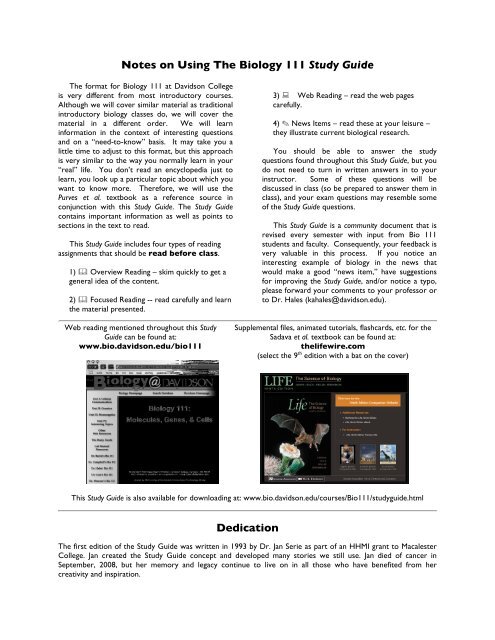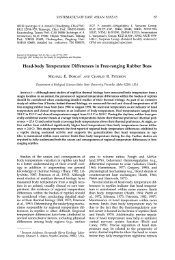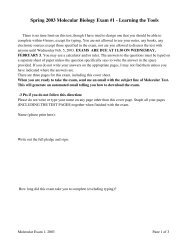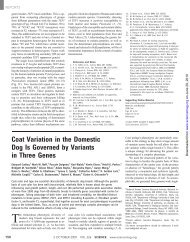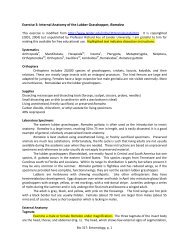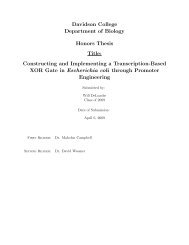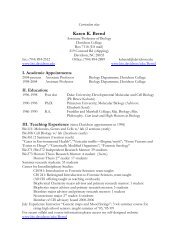Fall Semester 2012 Biology 111 Molecules, Genes, & Cells Study ...
Fall Semester 2012 Biology 111 Molecules, Genes, & Cells Study ...
Fall Semester 2012 Biology 111 Molecules, Genes, & Cells Study ...
You also want an ePaper? Increase the reach of your titles
YUMPU automatically turns print PDFs into web optimized ePapers that Google loves.
Notes on Using The <strong>Biology</strong> <strong>111</strong> <strong>Study</strong> Guide<br />
The format for <strong>Biology</strong> <strong>111</strong> at Davidson College<br />
is very different from most introductory courses.<br />
Although we will cover similar material as traditional<br />
introductory biology classes do, we will cover the<br />
material in a different order. We will learn<br />
information in the context of interesting questions<br />
and on a “need-to-know” basis. It may take you a<br />
little time to adjust to this format, but this approach<br />
is very similar to the way you normally learn in your<br />
“real” life. You don’t read an encyclopedia just to<br />
learn, you look up a particular topic about which you<br />
want to know more. Therefore, we will use the<br />
Purves et al. textbook as a reference source in<br />
conjunction with this <strong>Study</strong> Guide. The <strong>Study</strong> Guide<br />
contains important information as well as points to<br />
sections in the text to read.<br />
This <strong>Study</strong> Guide includes four types of reading<br />
assignments that should be read before class.<br />
1) � Overview Reading – skim quickly to get a<br />
general idea of the content.<br />
2) � Focused Reading -- read carefully and learn<br />
the material presented.<br />
Web reading mentioned throughout this <strong>Study</strong><br />
Guide can be found at:<br />
www.bio.davidson.edu/bio<strong>111</strong><br />
3) � Web Reading – read the web pages<br />
carefully.<br />
4) ✎ News Items – read these at your leisure –<br />
they illustrate current biological research.<br />
You should be able to answer the study<br />
questions found throughout this <strong>Study</strong> Guide, but you<br />
do not need to turn in written answers in to your<br />
instructor. Some of these questions will be<br />
discussed in class (so be prepared to answer them in<br />
class), and your exam questions may resemble some<br />
of the <strong>Study</strong> Guide questions.<br />
This <strong>Study</strong> Guide is a community document that is<br />
revised every semester with input from Bio <strong>111</strong><br />
students and faculty. Consequently, your feedback is<br />
very valuable in this process. If you notice an<br />
interesting example of biology in the news that<br />
would make a good “news item,” have suggestions<br />
for improving the <strong>Study</strong> Guide, and/or notice a typo,<br />
please forward your comments to your professor or<br />
to Dr. Hales (kahales@davidson.edu).<br />
Supplemental files, animated tutorials, flashcards, etc. for the<br />
Sadava et al. textbook can be found at:<br />
thelifewire.com<br />
(select the 9 th edition with a bat on the cover)<br />
This <strong>Study</strong> Guide is also available for downloading at: www.bio.davidson.edu/courses/Bio<strong>111</strong>/studyguide.html<br />
Dedication<br />
The first edition of the <strong>Study</strong> Guide was written in 1993 by Dr. Jan Serie as part of an HHMI grant to Macalester<br />
College. Jan created the <strong>Study</strong> Guide concept and developed many stories we still use. Jan died of cancer in<br />
September, 2008, but her memory and legacy continue to live on in all those who have benefited from her<br />
creativity and inspiration.


